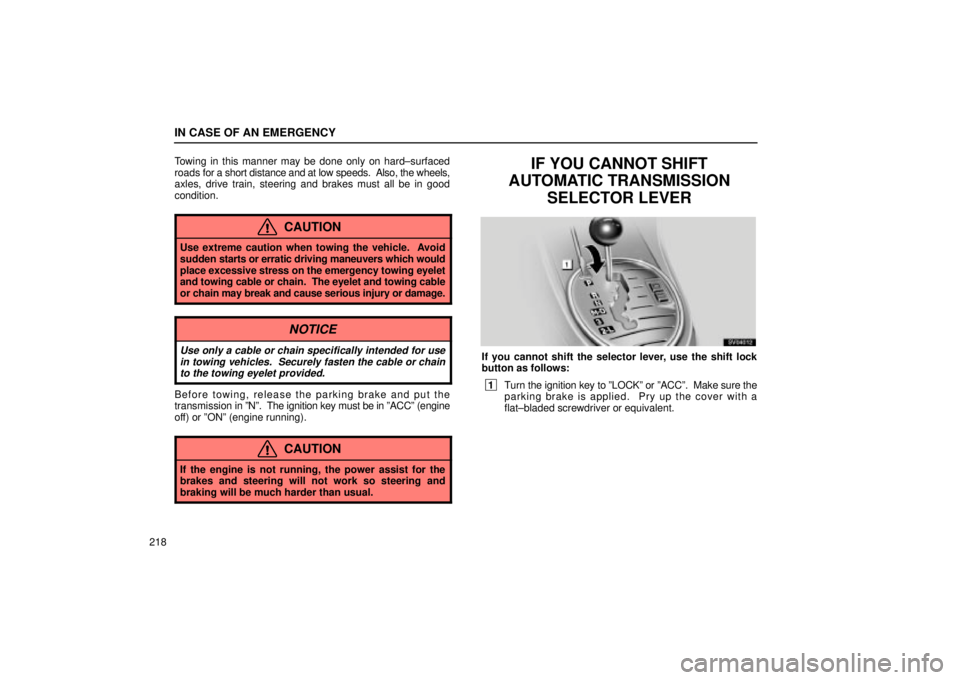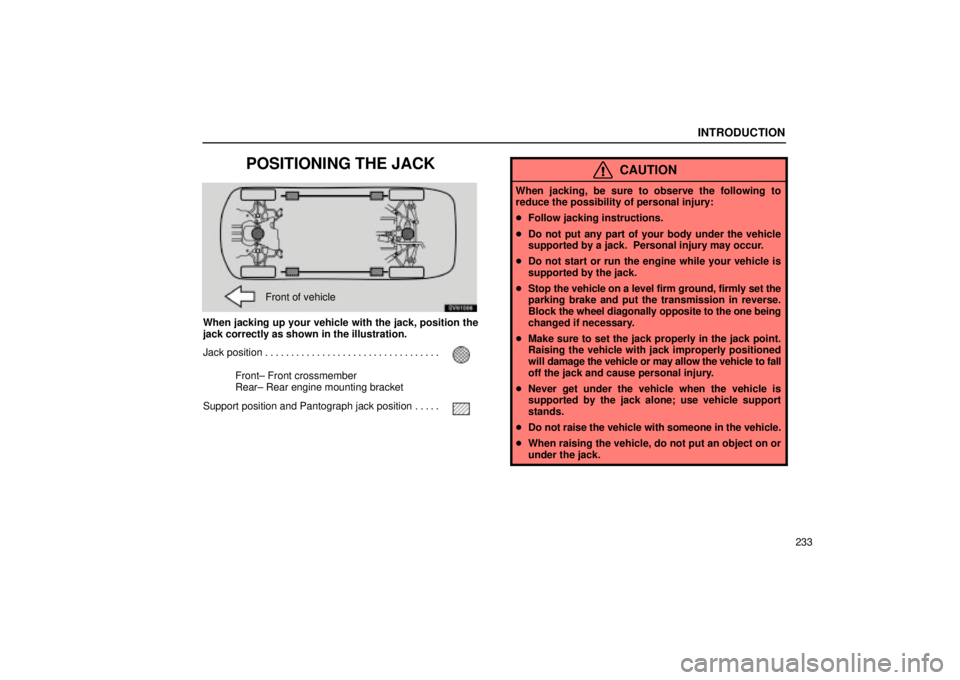Page 223 of 307
IN CASE OF AN EMERGENCY
210
SV04003
5. Position the jack at the jack points as shown.
Make sure the jack is positioned on a level and solid surface.
SS41010
6. After making sure no one is in the vehicle, raise it high
enough so that the spare tire can be installed.
Allow for the fact that you need more ground clearance when
putting on the spare tire than when removing the flat tire.
To raise the vehicle, insert the jack handle into the jack (it is a
loose fit) and turn it clockwise. As the jack touches the vehicle
and begins to lift, double±check that it is properly positioned.
CAUTION
Never get under the vehicle when the vehicle is
supported by the jack alone.
Page 225 of 307

IN CASE OF AN EMERGENCY
212
SS41013
8. Reinstall all the wheel nuts finger tight.
Align the holes in the wheel with the bolts. Then lift up the
wheel and get at least the top bolt started through its hole.
Wiggle the tire and press it back over the other bolts.
Reinstall the wheel nuts and tighten them as much as you can
by hand. Press the tire back and see if you can tighten them
more.
SS41014
9. Lower the vehicle completely and tighten the wheel
nuts.
Turn the jack handle counterclockwise to lower the vehicle.
Use only the wheel nut wrench to tighten the nuts. Do not use
other tools or any additional leverage other than your hands,
such as a hammer, pipe or your foot. Make sure the wrench
is securely engaged over the nut.
Tighten each nut a little at a time in the order shown. Repeat
the process until all the nuts are tight.
CAUTION
� When lowering the vehicle, make sure all portions of
your body and all other persons around will not be
injured as the vehicle is lowered to the ground.
� As soon as possible after changing wheels, have the
wheel nuts tightened by torque wrench at 103 N´m
(10.5 kgf´m, 76 ft´lbf.).
Page 228 of 307
IN CASE OF AN EMERGENCY
215
�
From rear
SS41016b
Place the ignition key in the ºACCº position.
NOTICE
�Do not tow with the key removed or in the ºLOCKº
position, as the steering lock mechanism is notstrong enough to hold the front wheels straight.
�When lifting wheels, take care to ensure adequateground clearance for towing at the opposite end ofthe raised vehicle. Otherwise, the bumper and/orunderbody of the towed vehicle will be damagedduring towing.
(b) Using a flat bed truck
SS41017
� Tie down points
40E014
Page 231 of 307

IN CASE OF AN EMERGENCY
218Towing in this manner may be done only on hard±surfaced
roads
for a short distance and at low speeds. Also, the wheels,
axles, drive train, steering and brakes must all be in good
condition.
CAUTION
Use extreme caution when towing the vehicle. Avoid
sudden starts or erratic driving maneuvers which would
place excessive stress on the emergency towing eyelet
and towing cable or chain. The eyelet and towing cable
or chain may break and cause serious injury or damage.
NOTICE
Use only a cable or chain specifically intended for use in towing vehicles. Securely fasten the cable or chainto the towing eyelet provided.
Before towing, release the parking brake and put the
transmission in ºNº. The ignition key must be in ºACCº (engine
off) or ºONº (engine running).
CAUTION
If the engine is not running, the power assist for the
brakes and steering will not work so steering and
braking will be much harder than usual.
IF YOU CANNOT SHIFT
AUTOMATIC TRANSMISSION SELECTOR LEVER
SV04012
If you cannot shift the selector lever, use the shift lock
button as follows:
1Turn the ignition key to ºLOCKº or ºACCº. Make sure the
parking brake is applied. Pry up the cover with a
flat±bladed screwdriver or equivalent.
Page 232 of 307

IN CASE OF AN EMERGENCY
219
SV04013
2Insert your finger, the screwdriver or equivalent into the
hole to push down the shift lock override button. You can
shift the selector lever while pushing the button.
For your safety, keep the brake pedal depressed.
Be sure to have the system checked by your Lexus dealer as
soon as possible.
IF YOU LOSE YOUR KEYS OR LOCK YOURSELF OUT
You can purchase a new key at your Lexus dealer if you
can give them the key number and master key.
Even if you lose only one key, contact your Lexus dealer to
make a new key. If you lose all your master keys, you cannot
make new keys; the whole engine immobiliser system must be
replaced.
See the suggestion given in ºKeysº on page 8.
You can use the wireless remote control system with the new
key. Contact your Lexus dealer for detailed information.
If your keys are locked in the vehicle and you cannot get a
duplicate, many Lexus dealers can still open the door for you,
using their special tools. If you must break a window to get in,
we suggest breaking the smallest side window because it is the
least expensive to replace. Be extremely cautious to avoid
cuts from the glass.
Page 237 of 307

MAINTENANCE
224Tire rotation
Rotate the tires according to the maintenance schedule. (For
scheduled maintenance information, please refer to the
ªOwner's Manual Supplementº or ªScheduled Maintenanceº.)
See page 255 for additional information.
Fluid leaks
Check under
neath for leaking fuel, oil, water or other fluid after
the vehicle has been parked for a while. If you smell fuel fumes
or notice any leak, have the cause found and corrected
immediately.
Doors and engine hood
Check that all doors, including trunk lid, operate smoothly and
all latches lock securely. Make sure the engine hood
secondary latch secures the hood when the primary latch is
released.
Vehicle interior
Items listed below should be checked regularly, e.g. while
performing periodic services, cleaning the vehicle, etc.
Lights
Make sure the headlight, stop lights, tail lights, turn signal
lights, and other lights are working. Check headlight aim.
Service reminder indicators and warning buzzers
Check that all service reminder indicators and warning
buzzers function properly. Steering wheel
Check that it has the specified free play. Be alert for changes
in steering condition, such as hard steering, excessive free
play or strange noise.
Seats
Check that all front seat controls such as seat adjusters,
seatback recliner, etc. operate smoothly. Ch
eck that the head
restraints move up and down smoothly and that the locks hold
securely in any latched position.
Seat belts
Check that the seat belt system such as buckles, retractors
and anchors operate properly and smoothly. Make sure the
belt webbing is not cut, frayed, worn or damaged.
Accelerator pedal
Check the pedal for smooth operation and uneven pedal ef fort
or catching.
Brake pedal
Check the pedal for smooth operation and the proper
clearance and free play. Check the brake booster function.
Brakes
At a safe place, check that the brakes do not pull to one side
when applied.
Parking brake
Check that the lever has the proper travel and that, on a safe
incline, your vehicle is held securely with only the parking
brake applied.
Page 241 of 307
INTRODUCTION
228
VEHICLE IDENTIFICATION
SV61001
The vehicle identification number (VIN) is the legal
identifier for your vehicle. This number is on the left top
of the instrument panel and can be seen through the
windshield from outside.
This is the primary identification number for your Lexus. It is
used in registering the ownership of your vehicle.
SV63004
The vehicle identification number (VIN) is also on the
Certification Label.
SV61002
The engine number is stamped on the engine block as
shown.
Page 246 of 307

INTRODUCTION
233
POSITIONING THE JACK
SV61006
Front of vehicle
When jacking up your vehicle with the jack, position the
jack correctly as shown in the illustration.
Jack position
. . . . . . . . . . . . . . . . . . . . . . . . . . . . . . . . . .
Front± Front crossmember
Rear± Rear engine mounting bracket
Support position and Pantograph jack position
. . . . .
CAUTION
When jacking, be sure to observe the following to
reduce the possibility of personal injury:
� Follow jacking instructions.
� Do not put any part of your body under the vehicle
supported by a jack. Personal injury may occur.
� Do not start or run the engine while your vehicle is
supported by the jack.
� Stop the vehicle on a level firm ground, firmly set the
parking brake and put the transmission in reverse.
Block the wheel diagonally opposite to the one being
changed if necessary.
� Make sure to set the jack properly in the jack point.
Raising the vehicle with jack improperly positioned
will damage the vehicle or may allow the vehicle to fall
off the jack and cause personal injury.
� Never get under the vehicle when the vehicle is
supported by the jack alone; use vehicle support
stands.
� Do not raise the vehicle with someone in the vehicle.
� When raising the vehicle, do not put an object on or
under the jack.